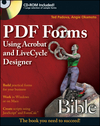While recently helping a few people with some issues related to HTTP submissions from XFA forms, I ended-up creating new Data Service that helps with testing HTTP Submit Buttons.
The service is quite simple: It displays what you submit to it. Since Designer’s “PDF Preview” tab is actually an instance of Internet Explorer hosting a PDF version of the form you’re previewing (a temporary PDF if your form is saved as an XDP or is new), the results are conveniently displayed within the tab itself after clicking on the submit button.
To use the service, simply use either an http submit button (or a regular button with its “Object palette > Field tab > Control Type property” set to “Submit”) and set its URL to:
http://forms.stefcameron.com/services/http-submit-test/
The idea is to use this service as a means to test/debug your forms before spending time writing the actual server code that will receive the data. You can also use it to ensure that you are submitting the correct data to a third-party service (for which you don’t control the server-side code).
Continue reading…
Posted by Stefan Cameron on December 16th, 2009
Filed under
Data Binding,
Debugging,
Tables,
Tutorials,
XFA

Last February, I announced the release of a new Designer book titled, “PDF Forms Using Acrobat and LiveCycle Designer Bible”.
Over the past few months, I had the opportunity to review it and I thought I would share my comments, with respect to the second-half of the book, which deals with LiveCycle Designer ES and XFA forms, to help you decide if it would be a good book for you*. (The first-half deals with authoring PDF forms, a.k.a. AcroForms, in Acrobat and is beyond the scope of my blog.)
Pros:
- explains the licensing agreement involved when enabling forms for Reader using Acrobat’s “Extend Features in Adobe Reader” feature (p. 268) — this is a frequently-used feature however its governing licensing agreement, seldom understood, is explained here in “plain English”;
- presents and reasons through different design approaches for a particular solution, helping the reader make an informed decision on the best course of action;
- anything and everything you could possibly want to know is dealt with in some way;
- lots of important, time-saving insights in the inline ‘notes’;
- something for everyone from beginner to advanced;
- many cross-references between various topics, making it very easy to start in any chapter and still find all the information you need.
Caution:
- risk of “information overload” — use this book as reference since it’s not a light read, though their goal is simply to present a myriad of options and let you pick the one that best suits your needs.
Overview of Topics Covered:
- all about tables (from simple layouts to advanced);
- data merging with bindings;
- Designer user interface details and lots of tips and tricks for accelerating form layout tasks;
- working with static forms (with PDF backgrounds) and dynamic forms, highlighting the differences;
- great details on all sorts of pagination options;
- lots of detail on JavaScript and FormCalc, good scripting exercises with explanations, debugging tips, table with JavaScript and equivalent FormCalc functions to make it easy to script in either language if the other is more familiar to you;
- form deployment options;
- when and how to use data connections in your forms (XML, schema, database, web service) and setting data bindings;
- great overview of LiveCycle ES, its components (e.g. LC Forms, LC Reader Extensions, LC Rights Management, LC Content Services, etc.) and what they do.
This book is available now on Amazon.com and Wiley.com and elsewhere.
* Please note that these opinions are not necessarily those of Adobe Systems Incorporated.
Posted by Stefan Cameron on November 13th, 2009
Filed under
Acrobat,
Books,
Data Binding,
Designer,
Instance Manager,
Scripting,
Tables,
XFA
Have you ever needed to create data nodes in the Data DOM on-the-fly? How about a need to parse XML obtained from a web service data connection in order to find a value for some property? If that’s the case, then you’ll find-out how to do it in this article.
Creating Data Nodes
In a similar article, John Brinkman showed how to create form variable nodes at runtime however what’s not obvious about data nodes is that you don’t create them using
a class name of your choice.
For example, say you wanted to create the following data node structure:
<custom>
<message>Hello World!</message>
</custom>
Continue reading…
Posted by Stefan Cameron on June 1st, 2009
Filed under
CM,
Data Binding,
Instance Manager,
Scripting,
Tables,
Tutorials,
XFA
It seems that calculating totals in an expandable table with a dynamic/repeatable row is a hot topic lately so I thought I would post a tutorial on how to build a simple table which represents a purchase order where you can add and remove line items and various totals are automatically calculated.
Before we get started, you’ll need Designer 7.1 and Acrobat/Reader 7.0.5 at minimum to run through this tutorial. I will be using Designer 8.2 and Acrobat/Reader 9.0 to do the tutorial so it’s possible some of the UI may have changed slightly since the 7.1/7.05 versions.
Continue reading…
Posted by Stefan Cameron on February 25th, 2009
Filed under
Data Binding,
Designer,
FormCalc,
Scripting,
Tables,
Tutorials,
XFA
The recording of the Acrobat User Community eSeminar on Advanced Forms and LiveCycle Designer by Easel Solution’s Angie Okamoto is now available for viewing. Angie demonstrates advanced concepts in creating dynamic forms with LC Designer and you can also see all of the Q&A comment threads between the attendees and the team of specialists answering the questions.
Posted by Stefan Cameron on February 13th, 2009
Filed under
Data Binding,
Designer,
Instance Manager,
Scripting,
Tables,
Tutorials

